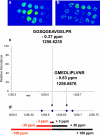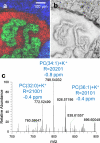Mass spectrometry imaging with high resolution in mass and space
- PMID: 23652571
- PMCID: PMC3656243
- DOI: 10.1007/s00418-013-1097-6
Mass spectrometry imaging with high resolution in mass and space
Abstract
Mass spectrometry (MS) imaging links molecular information and the spatial distribution of analytes within a sample. In contrast to most histochemical techniques, mass spectrometry imaging can differentiate molecular modifications and does not require labeling of targeted compounds. We have recently introduced the first mass spectrometry imaging method that provides highly specific molecular information (high resolution and accuracy in mass) at cellular dimensions (high resolution in space). This method is based on a matrix-assisted laser desorption/ionization (MALDI) imaging source working at atmospheric pressure which is coupled to an orbital trapping mass spectrometer. Here, we present a number of application examples and demonstrate the benefit of 'mass spectrometry imaging with high resolution in mass and space.' Phospholipids, peptides and drug compounds were imaged in a number of tissue samples at a spatial resolution of 5-10 μm. Proteins were analyzed after on-tissue tryptic digestion at 50-μm resolution. Additional applications include the analysis of single cells and of human lung carcinoma tissue as well as the first MALDI imaging measurement of tissue at 3 μm pixel size. MS image analysis for all these experiments showed excellent correlation with histological staining evaluation. The high mass resolution (R = 30,000) and mass accuracy (typically 1 ppm) proved to be essential for specific image generation and reliable identification of analytes in tissue samples. The ability to combine the required high-quality mass analysis with spatial resolution in the range of single cells is a unique feature of our method. With that, it has the potential to supplement classical histochemical protocols and to provide new insights about molecular processes on the cellular level.
Figures











Similar articles
-
High-resolution matrix-assisted laser desorption/ionization imaging of tryptic peptides from tissue.Rapid Commun Mass Spectrom. 2012 May 15;26(9):1141-6. doi: 10.1002/rcm.6192. Rapid Commun Mass Spectrom. 2012. PMID: 22467465
-
Atmospheric-Pressure MALDI Mass Spectrometry Imaging at 213 nm Laser Wavelength.J Am Soc Mass Spectrom. 2020 Feb 5;31(2):326-335. doi: 10.1021/jasms.9b00052. Epub 2020 Jan 7. J Am Soc Mass Spectrom. 2020. PMID: 32031384
-
A comprehensive high-resolution mass spectrometry approach for characterization of metabolites by combination of ambient ionization, chromatography and imaging methods.Rapid Commun Mass Spectrom. 2014 Aug 30;28(16):1779-91. doi: 10.1002/rcm.6960. Rapid Commun Mass Spectrom. 2014. PMID: 25559448
-
The synergy of elemental and biomolecular mass spectrometry: new analytical strategies in life sciences.Chem Soc Rev. 2009 Jul;38(7):1969-83. doi: 10.1039/b618635c. Epub 2009 Apr 16. Chem Soc Rev. 2009. PMID: 19551177 Review.
-
Molecular mass spectrometry imaging in biomedical and life science research.Histochem Cell Biol. 2010 Nov;134(5):423-43. doi: 10.1007/s00418-010-0753-3. Epub 2010 Oct 28. Histochem Cell Biol. 2010. PMID: 20981554 Review.
Cited by
-
Resolving Metabolic Heterogeneity in Experimental Models of the Tumor Microenvironment from a Stable Isotope Resolved Metabolomics Perspective.Metabolites. 2020 Jun 15;10(6):249. doi: 10.3390/metabo10060249. Metabolites. 2020. PMID: 32549391 Free PMC article. Review.
-
A method to prevent protein delocalization in imaging mass spectrometry of non-adherent tissues: application to small vertebrate lens imaging.Anal Bioanal Chem. 2015 Mar;407(8):2311-20. doi: 10.1007/s00216-015-8489-5. Epub 2015 Feb 10. Anal Bioanal Chem. 2015. PMID: 25665708 Free PMC article.
-
Evaluation and comparison of unsupervised methods for the extraction of spatial patterns from mass spectrometry imaging data (MSI).Sci Rep. 2022 Sep 20;12(1):15687. doi: 10.1038/s41598-022-19365-4. Sci Rep. 2022. PMID: 36127378 Free PMC article.
-
Metabolic insights from mass spectrometry imaging of biofilms: A perspective from model microorganisms.Methods. 2024 Apr;224:21-34. doi: 10.1016/j.ymeth.2024.01.014. Epub 2024 Jan 29. Methods. 2024. PMID: 38295894 Free PMC article. Review.
-
Spatial metabolomics and its application in the liver.Hepatology. 2024 May 1;79(5):1158-1179. doi: 10.1097/HEP.0000000000000341. Epub 2023 Feb 23. Hepatology. 2024. PMID: 36811413 Free PMC article. Review.
References
Publication types
MeSH terms
Substances
LinkOut - more resources
Full Text Sources
Other Literature Sources

